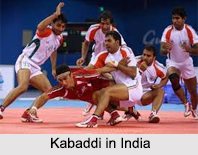 Kabaddi in India is counted among the most common and widely played traditional sports. There is a popular belief that Kabaddi originated in the Indian state ofTamil Nadu, almost 4,000 years ago. According to a legend, this game came into existence, when a boy hit another boy for his candy. The boy who was hit chased the boy who hit him, and hit him back and ran away. The feature of holding the breath while chasing, was added later when the game evolved. Kabaddi is the game, where one person play against seven people. Kabaddi is also known as the "Game of the Masses" and it has simple, easy to comprehend rules.
Kabaddi in India is counted among the most common and widely played traditional sports. There is a popular belief that Kabaddi originated in the Indian state ofTamil Nadu, almost 4,000 years ago. According to a legend, this game came into existence, when a boy hit another boy for his candy. The boy who was hit chased the boy who hit him, and hit him back and ran away. The feature of holding the breath while chasing, was added later when the game evolved. Kabaddi is the game, where one person play against seven people. Kabaddi is also known as the "Game of the Masses" and it has simple, easy to comprehend rules.The game of Kabaddi requires minimum equipment while having all the ingredients of thrill and excitement and audience appeal. Sometimes, the people enjoy the game of Kabaddi more than any other popular game, like Football or Basketball. This is a team game that requires both skill and power on behalf of the players, and it also combines the characteristics of wrestling and rugby.
Legends Attached to Kabaddi
In India, Kabaddi is quite famous and popular in the state of Punjab. There is also a popular belief that the game has its roots in the way Abhimanyu was killed in Chakravyuha by the Kauravas. Kabaddi is a rather simple and inexpensive game, and it does not require a massive playing area, or any expensive equipments. There are also some other ancient scripts that refers to the existence of Kabaddi in India. In Mahabharata, Arjuna had a unique talent in the game of Kabaddi, as he was able to go inside the wall of enemies, destroy them all and come back unscathed. According to the Buddhist literature, Gautam Buddha used to play Kabaddi for recreation in the early era. Apart from those manuscripts, history also reveals that princes of yore loved playing Kabaddi and took the game as a means to display their strength and won their brides. With due course of time, the game earned a lot of popularity in the Southern Part of Asia. For this inexpensive nature, the game of Kabaddi has become extremely popular in rural India.

History of Kabaddi
Kabaddi is probably the only game of offence and defence in which attack is an individual attempt, while defence is a combined effort. The Tamil Language speaking people know the game in various names like Kabaddi, Sadugudu, Gudugudu, Palinjadugudu and Sadugoodatthi (Tamil). The word 'Kabaddi' may have originated from the Tamil words kai (hand) and pidi (catch).
Naming of Kabaddi
Kabaddi is also known as "Chedugudu" or "Hu-Tu-Tu" in southern parts of India, "Hadudu" (Men) and "Chu - Kit-Kit" (women) in eastern India, and as Kabaddi in northern India. The sport has earned a lot of popularity in the other Asian nations like Nepal, Bangladesh, Sri Lanka, Japan and Pakistan.
Kabaddi in Modern India
In modern times, Kabaddi in India attained National status in the year 1918. The state of Maharashtra is considered to be a pioneer for bringing the game to the National platform. The standard rules and regulations for Kabaddi were also formulated in 1918; however, the rules were brought out in print in the year 1923. An All India Tournament was also organized at Baroda following these rules, in 1923. Since then, the journey of Kabaddi in India has always been towards success and more popularity and numerous tournaments are now organized all over India throughout the year. The game got international exposure for the time during the 1936 Berlin Olympic Games. The game was also introduced in the Indian Olympic Games at Calcutta (now in Kolkata), in 1938.
To know more, visit the link below: